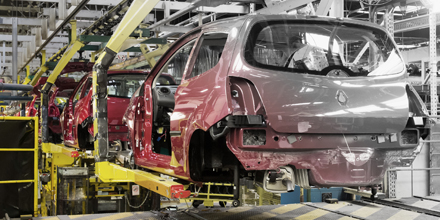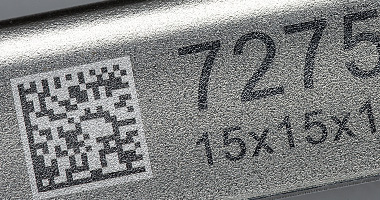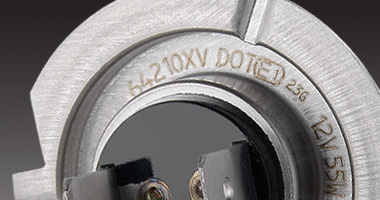Imagine an automotive part or beverage can without a traceability code. How would manufacturers efficiently recall affected products if a defect were discovered? Coding and marking on metal surfaces are not just a requirement—these processes safeguard and support quality, compliance, and brand protection. Let’s explore the latest trends and solutions shaping this crucial industry.
The importance of coding and marking on metal
Every metal component tells a story—whether it’s an automotive part, an aerospace component, or a beverage can. Without clear and durable codes, traceability, compliance, and brand protection would be at risk. From manufacturing dates and batch numbers to QR codes and regulatory marks, coding on metal surfaces helps ensure product authenticity and supply chain security. But not all printing and marking methods are equal. Choosing the right technology is crucial to achieving lasting, high-quality codes that withstand extreme conditions.

Choosing the right marking technology for different metal surfaces
When it comes to marking and coding on metal surfaces, the choice of technology is as diverse as the metals themselves. Metals such as aluminum, steel, and copper each possess unique properties that necessitate specific printing and marking solutions for optimal adhesion and visibility.
Aluminum: Overcoming coding challenges
Aluminum is widely used in the beverage, aerospace, and electronics industries due to its lightweight and recyclable nature. However, marking on aluminum cans presents unique challenges, such as curved surfaces and reflective metal finishes.
Suggested solutions:
Continuous inkjet (CIJ): Traditionally preferred for high-speed printing on beverage cans due to its adaptability to various surfaces.
Laser marking: Increasingly popular for producing permanent, high-contrast codes by engraving the surface and providing code durability when subjected to extreme conditions, chemicals, and abrasion.
- CO₂ lasers – Best for marking coated aluminum surfaces (e.g., anodized aluminum).
- Fiber lasers – Ideal for marking uncoated aluminum.
Stay ahead with real-time updates on the latest news:
Stainless steel: Precision marking in high-performance industries
Known for its hardness and corrosion resistance, stainless steel is commonly used for automotive parts, aerospace parts, and medical devices. Codes on stainless steel must remain readable and permanent despite exposure to extreme conditions.

Suggested solutions:
- Laser marking: Preferred for permanent, high-contrast marking using techniques like:
- Engraving: Deep, long-lasting marks ideal for aerospace and medical applications.
- Ablation: Removes surface coatings for high-contrast results.
- Color change: A unique method for black or white marking on stainless steel.
- Continuous inkjet (CIJ): Great for high-speed coding on industrial production lines.
Copper: Effective marking requires the management of heat and conductivity
Copper, often used in electronics and electrical wiring, has high thermal conductivity, making it trickier to mark without affecting the material.
Suggested solutions:
- Fiber laser marking: Delivers precise, heat-resistant marks without damaging the component.
- Continuous inkjet (CIJ): Provides a cost-effective, flexible solution for fast, consistent coding.
The selection of a marking solution should include consideration of factors like the metal’s composition, the production environment, and the longevity required for the code or mark. Understanding these nuances helps ensure that the chosen method not only provides clear and durable identification but also complements the manufacturing workflow with efficiency and consistency in every mark.
Solving metal marking challenges: Common issues and proven solutions
1. Traceability and code permanence: Traceability is often a critical requirement for metal parts, especially in automotive applications. Codes must remain permanent and visible throughout the product lifecycle, particularly before and after environmental coating, acid dip treatments, and paint processes. CIJ and laser marking technologies offer robust solutions. CIJ printers provide high-speed, non-contact printing with quick-drying inks that adhere well to metal surfaces. Laser marking goes a step further by offering code permanence and tamper-proof markings that withstand harsh conditions.
2. High-speed production: Industries such as automotive and beverage operate at high speeds. It is essential for coding and marking solutions to keep up. Both CIJ printers and laser marking systems are known for their ability to print at high speeds without compromising on quality.
3. Flexibility: Modern production lines benefit greatly from equipment that is both small and versatile. Compact designs can fit easily into different production environments, using flexible laser beam turning units and CIJ printheads on umbilicals to adapt to tight spaces. Enhanced connectivity options, including cellular and Wi-Fi, ensure secure remote access and analytical capabilities. Additionally, systems with IP54 or IP65 standards that withstand tough industrial conditions, such as dust and washdowns, provide reliable performance.
4. Maintenance: Uptime and maintenance reliability are crucial factors. Manufacturers are reluctant to adopt new systems if they require high levels of maintenance. However, advanced coding and marking systems can help reduce the need for manual intervention, potentially leading to cost savings and increased productivity.

5. Environmental considerations: With an increasing emphasis on sustainability, manufacturers are looking for eco-friendly coding and marking solutions. Laser marking systems, which do not require consumables like inks and ribbons, can help reduce waste. Additionally, certain CIJ inks can help support brands’ and manufacturers’ efforts in meeting their sustainability goals.
The future of coding and marking: Key trends & innovations1
The coding and marking solutions industry is experiencing significant growth driven by the demand for efficient and reliable marking systems across various industries. Key trends include:
- Increased adoption of laser marking: Laser marking is gaining popularity due to its ability to provide permanent, high-quality marks without the need for consumables like fluids. This technology is particularly favored in the automotive and aerospace industries, where durability and precision are paramount.
- Sustainability and eco-friendly solutions: There is a growing emphasis on sustainability. Manufacturers are increasingly adopting coding and marking solutions that can minimize environmental impact. This includes the use of CIJ inks that can help meet safety, environmental, and regulatory requirements, as well as the shift towards laser marking systems.
- Technological advancements: The coding and marking industry is witnessing continuous advancements. Innovations such as smart printers with IoT capabilities, AI-driven predictive maintenance, and enhanced user interfaces are making coding and marking systems more efficient and user-friendly.
Conclusion
Clear, accurate, and durable codes and marks on metal are essential for ensuring traceability, compliance, and brand integrity. By addressing common pain points, staying abreast of market trends, and partnering with a solution provider that offers comprehensive testing and a full range of solutions, manufacturers can choose the right technology to meet their needs.
1 Coding And Marking Solutions Market Size & Share Analysis – Industry Research Report – Growth Trends
